History, South Africa, Australopithecus africanus, Klasies
River, Hottentot, Bushmen, Khoi, San, Bantu, Bartholomeus Dias, Jan van
Riebeck, Good Hope, Huguenots, Kimberley, Cecil Rhodes | Messina,Transvaal,
Venda, Baobab, Pietersburg | Magoebas kloof, Haenertburg,
Ebenezer, Tzaneen, Gravelotte, Mica, Abel erasmus, Strydom, Bourke's luck,
Blyde river, Berlin falls, Gods window, Rondavels, Marieps kop, Graskop,
Pelgrims rest, Sabi, Hazy view, White river | Krugerpark,
Nelspruit | Malelane, Swaziland, Mbabane, Matsemo, Mguni,
Manzini, Big Bend, Lavumisa | Hluhluwe, Kwazulu Natal, Nyala,
Damazulu, Umfalesi | Mtatatuba, St. Lucia | Durban,
Sea World | Pietermaritzburg, Howick, Midmar Res., Nottingham
Road, Rosetta, Mooi River, Giant's Castle, San, Mtabamhlope, Draycot, Loskop,
Mafadi, Drakensbergen, Blue Cave |Pretoria, Winterton,
Bergville, Sterkfontein, Orange Free State, Harrismith, Soweto, Johannesburg,
Krugerhuis, Voortrekkers Monument, National Zoological gardens |
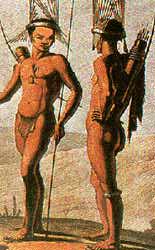 South Africa is actually home to some of the oldest fossil human
remains in the world. Three million-year-old fossil remains of an early
human-like species Australopithecus africanus, have been discovered at
a number of sites on the highveld. The exact way in which the evolution of the
early human-like species into modern human took place is still a matter of
considerable debate. According to some archaeologist the earliest fossil
remains anywhere in the world of modern man come from Klasies River
mount and Border Cave on KwaZulu-Natal border. May be, the Khoi
and San people of Southern Africa, called Hottentot s or Bushmen
by the European settler are the direct descendants of the early humans whose
fossils are found across South Africa. Up until 20,000 years ago the
ancestors of the Khoi and San people were all hunter-gatherers
living in small egalitarian communities of about 20-30 people. They were
nomadic and moved with the herds of wild game as they undertook seasonal
migrations. Their tools were made out of stone, water was stored in Ostrich
shells and they lived in caves or simple tents. Sometimes about 20,000 years
ago some of these communities underwent a huge, and rapid, change that was to
have far reaching effects on their lifestyles. At this time a number of groups
acquired domesticated livestock, fat tailed sheep, probably domesticated
somewhere in northern Africa. Later they were able to acquire cattle
from Bantu groups who migrated from west Africa into South
Africa. With livestock came the concept of ownership of property and it
was possible for one or two individuals to amass wealth. Around 50 AD Bantu
speaking people began migrating, bringing with them new technologies,
especially iron smelting and new livestock. Where they came into contact with San
and Khoi, they pushing them into the desert and mountains. The first
Europeans to make contact with these different social groups were the Portuguese
sailors and in 1487 Bartholomeus Dias was de first who made it around
the cape of Good Hope. Over the next 200 years more traders including
the Dutch began to make the journey to the East. The Dutch were the first
European trading power to set up a permanent settlement in 1652 under command
of Jan van Riebeck. After finishing their contracts they settle
themselves as independent farmers called burghers, their number was
soon increased by the arrival of new settlers from Holland and after 1685 Huguenots
fleeing French anti-protestant legislation. In 1795 the British sailed into False
Bay and annexed the Dutch colony, after which a long bloody war began,
because the original Dutch and French settlers and also some local groups were
extremely unhappy with British meddlesomeness. Finally, between 1835 and 1840,
a large number of settlers decided that they would set out with their families
and servants (and many black people) in search of new land beyond the British
colonial dictatorship. That migration became known as the Great Trek.
In 1867 alluvial diamonds were discovered near the confluence of the Hart and
Vaal rivers and a dry digging nearby, located on the new area of the farmers.
At the first there were numerous individual plots at the mines but these soon
became in hands of the highly gifted British villain Cecil Rhodes. Here
in Kimberley apartheid was born, all the coloured African
labour had to live in one big compound above the mine from which they were
prohibited to leave. The white labourers are free to go to their houses and Cecil
Rhodes made a agreement that the better paid jobs were for whites only...
South Africa is actually home to some of the oldest fossil human
remains in the world. Three million-year-old fossil remains of an early
human-like species Australopithecus africanus, have been discovered at
a number of sites on the highveld. The exact way in which the evolution of the
early human-like species into modern human took place is still a matter of
considerable debate. According to some archaeologist the earliest fossil
remains anywhere in the world of modern man come from Klasies River
mount and Border Cave on KwaZulu-Natal border. May be, the Khoi
and San people of Southern Africa, called Hottentot s or Bushmen
by the European settler are the direct descendants of the early humans whose
fossils are found across South Africa. Up until 20,000 years ago the
ancestors of the Khoi and San people were all hunter-gatherers
living in small egalitarian communities of about 20-30 people. They were
nomadic and moved with the herds of wild game as they undertook seasonal
migrations. Their tools were made out of stone, water was stored in Ostrich
shells and they lived in caves or simple tents. Sometimes about 20,000 years
ago some of these communities underwent a huge, and rapid, change that was to
have far reaching effects on their lifestyles. At this time a number of groups
acquired domesticated livestock, fat tailed sheep, probably domesticated
somewhere in northern Africa. Later they were able to acquire cattle
from Bantu groups who migrated from west Africa into South
Africa. With livestock came the concept of ownership of property and it
was possible for one or two individuals to amass wealth. Around 50 AD Bantu
speaking people began migrating, bringing with them new technologies,
especially iron smelting and new livestock. Where they came into contact with San
and Khoi, they pushing them into the desert and mountains. The first
Europeans to make contact with these different social groups were the Portuguese
sailors and in 1487 Bartholomeus Dias was de first who made it around
the cape of Good Hope. Over the next 200 years more traders including
the Dutch began to make the journey to the East. The Dutch were the first
European trading power to set up a permanent settlement in 1652 under command
of Jan van Riebeck. After finishing their contracts they settle
themselves as independent farmers called burghers, their number was
soon increased by the arrival of new settlers from Holland and after 1685 Huguenots
fleeing French anti-protestant legislation. In 1795 the British sailed into False
Bay and annexed the Dutch colony, after which a long bloody war began,
because the original Dutch and French settlers and also some local groups were
extremely unhappy with British meddlesomeness. Finally, between 1835 and 1840,
a large number of settlers decided that they would set out with their families
and servants (and many black people) in search of new land beyond the British
colonial dictatorship. That migration became known as the Great Trek.
In 1867 alluvial diamonds were discovered near the confluence of the Hart and
Vaal rivers and a dry digging nearby, located on the new area of the farmers.
At the first there were numerous individual plots at the mines but these soon
became in hands of the highly gifted British villain Cecil Rhodes. Here
in Kimberley apartheid was born, all the coloured African
labour had to live in one big compound above the mine from which they were
prohibited to leave. The white labourers are free to go to their houses and Cecil
Rhodes made a agreement that the better paid jobs were for whites only...
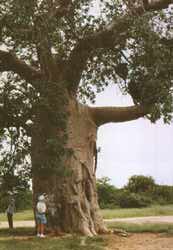
Our tour starts in Messina after a trip through Zimbabwe follows along
it Mysterious Venda trough Transvaal to Pietersburg. Mesina
was originally a mining camp set up around the copper mines which opened in
1905. Today it is a typical border place with shops and banks. At the banks it
is a time consuming procedure to exchange Traveller cheques, some banks ask to
proof your ownership, to use the ATM it is much quicker to obtain money. The
way to Pieterburg seems to be flat and dull. Along the way are many,
some more than 1000 years old, very big, Baobab trees. Pietersburg
is the regional capital of Northern Province. The town is surrounded by grass
plains and the immediate countryside is uninspiring.
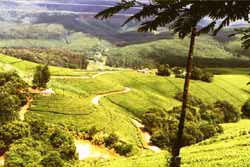
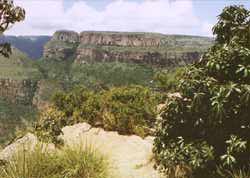 From Pieterburg we take a route via a range of hills known as the Magoebaskloof
covered with blue gum forest plantations, but in between there are lush
valleys, dams and lakes full of fish, the small village Haenertsburg
continues past the Ebenezer dam and winds through some beautiful
forested valleys before reaching the verdant Sapekoe Tea Estates (Middelkop)
at Tzaneen. The all black working woman earn R16 = Dfl 4.80 per day
including housing, water and electricity. The factory is modern and delivered
a good quality. From Tzaneen we continues via Gravelotte, Mica
through the Abel Erasmus Pas and the Strijdom Tunnel to Bourke's
Luck Potholes. The potholes are an unusual rock formation resembling a
Swiss cheese which have been created by swirling action of whirlpools where
the Treur and the Blyde rivers meet. The smooth cylindrical
holes are 15 million years old and are carved out of quartzite. the deepest
hole is 30 m although individual holes don't get much deeper than 6 m. The
name Bourke's Luck comes from, Tom Bourke swimming in one of the holes
found some gold. From the Potholes we continues via the Berlin falls to
Gods Window, a viewpoint at 1750 m right on the edge of the escarpment
where the cliffs drop away steeply into the tangle of forest below, with
breathtaking views over the lowveld, Blyde River and the Three
Rondavels. The subtropical rain forest in the ravines and the
montaneforest and protea veld in the dongas are the most impressive areas of
plant live. From Gods Window we continued our trip via Graskop
to Pelgrims Rest. Pelgrims Rest was South Africa's first
gold mining town. The town has been totally reconstructed to preserve a
fascinating part of the South Africa's cultural heritage. The small
miner's cottages with corrugated iron roofs and wooden walls line in the main
street and the atmosphere of a small town with his magistrate's court,
schoolhouse and church is not difficult to imagine. From Pelgrims Rest
we continued via Sabi and Hazy View to White River our
hotel Pine Lake Sun
From Pieterburg we take a route via a range of hills known as the Magoebaskloof
covered with blue gum forest plantations, but in between there are lush
valleys, dams and lakes full of fish, the small village Haenertsburg
continues past the Ebenezer dam and winds through some beautiful
forested valleys before reaching the verdant Sapekoe Tea Estates (Middelkop)
at Tzaneen. The all black working woman earn R16 = Dfl 4.80 per day
including housing, water and electricity. The factory is modern and delivered
a good quality. From Tzaneen we continues via Gravelotte, Mica
through the Abel Erasmus Pas and the Strijdom Tunnel to Bourke's
Luck Potholes. The potholes are an unusual rock formation resembling a
Swiss cheese which have been created by swirling action of whirlpools where
the Treur and the Blyde rivers meet. The smooth cylindrical
holes are 15 million years old and are carved out of quartzite. the deepest
hole is 30 m although individual holes don't get much deeper than 6 m. The
name Bourke's Luck comes from, Tom Bourke swimming in one of the holes
found some gold. From the Potholes we continues via the Berlin falls to
Gods Window, a viewpoint at 1750 m right on the edge of the escarpment
where the cliffs drop away steeply into the tangle of forest below, with
breathtaking views over the lowveld, Blyde River and the Three
Rondavels. The subtropical rain forest in the ravines and the
montaneforest and protea veld in the dongas are the most impressive areas of
plant live. From Gods Window we continued our trip via Graskop
to Pelgrims Rest. Pelgrims Rest was South Africa's first
gold mining town. The town has been totally reconstructed to preserve a
fascinating part of the South Africa's cultural heritage. The small
miner's cottages with corrugated iron roofs and wooden walls line in the main
street and the atmosphere of a small town with his magistrate's court,
schoolhouse and church is not difficult to imagine. From Pelgrims Rest
we continued via Sabi and Hazy View to White River our
hotel Pine Lake Sun
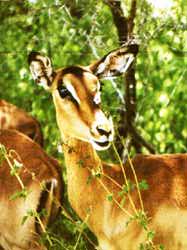 We spend
the whole day on safari in the Krugerpark from 6 till 18 o'clock
perfectly organised by Solitaire Tours & Travel at Nelpruit
including breakfast and a pick nick lunch in the park. Kruger National Park
covers an enormous region of wilderness extending from the Crocodile river
to the Limpopo. The park is 60 Km wide and 350 Km long, conserving
21,497 sq km, an area the size of Israel. The reality of modern Kruger
as conservation area is fascinating 500 bird species, 114 reptile, 49 fish, 33
amphibian, 146 mammal and over 23,000 plant species have been recorded. The
park receives 700,000 visitors a year and the park camps cater to the needs of
5000 visitors a day. In spite of the huge number of people passing through the
park on the 2600 km road network, the park has managed its magical atmosphere
as a more or less unspoiled African wilderness. But don't compare it with the
Kenya game parks like Masai Mara Game Reserve. Although we are at a wrong
time, January is the raining time, and the grasses are very tall, we saw a lot
of animals.
We spend
the whole day on safari in the Krugerpark from 6 till 18 o'clock
perfectly organised by Solitaire Tours & Travel at Nelpruit
including breakfast and a pick nick lunch in the park. Kruger National Park
covers an enormous region of wilderness extending from the Crocodile river
to the Limpopo. The park is 60 Km wide and 350 Km long, conserving
21,497 sq km, an area the size of Israel. The reality of modern Kruger
as conservation area is fascinating 500 bird species, 114 reptile, 49 fish, 33
amphibian, 146 mammal and over 23,000 plant species have been recorded. The
park receives 700,000 visitors a year and the park camps cater to the needs of
5000 visitors a day. In spite of the huge number of people passing through the
park on the 2600 km road network, the park has managed its magical atmosphere
as a more or less unspoiled African wilderness. But don't compare it with the
Kenya game parks like Masai Mara Game Reserve. Although we are at a wrong
time, January is the raining time, and the grasses are very tall, we saw a lot
of animals.
Surf to www.ecoafrica.com/krugerpark
for more information.
From White River we continued our trip through Krugerpark (Safari again) to Malelane the South gate via the border place Matsemo to Mbabane the capital of Swaziland for a overnight stop. Swaziland is a Kingdom the government is headed by the King Kim Msazi III, who is assisted by the Prime Minister; there are no legislative houses, the Senate and de House of Assembly. Non party elections were held and the power is in hands of the King. One of the attractions of Swaziland is the African atmosphere which pervades the country. We continue via Manzini, Big Bend en Lavumisa to Hluhluwe in Kwazulu-Natal.
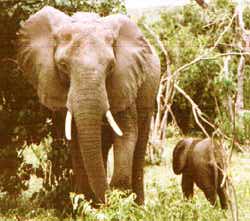 Hluhluwe
is small village surrounded by game farms, and we stayed there in a pleasant
hotel Hluhluwe Inn. We made a safari by bus through Hluhluwe
Nat.Park, one of Africa's oldest game reserves, managed as one unit since Hluhluwe
and Umfalozi were connected by the Corridor, this is the only park in
Natal where you can see the big five. Hluhluwe is named after the Umhluhluwe
or Thorny rope a climber which is found in the forest. Umfalozi is named after
Umfulawalosi or the river of fibres. Two rarely seen animals, the White Rhino
and the Nyala, are both present in the park. The biggest attraction are the
White Rhino which is successfully brought back from the brink of extinction.
The Nyala is a kind of antelope with yellow socks, specific the male is
imposing with large curling horns. A safari with the bus is not a really good
idea because you can't hear and smell the animals and its very difficult to
make pictures, so we arranged an open 4WD for the next day afternoon. We visit
the Dumazulu Traditional village which has been established to preserve
traditional Zulu crafts. There are displays of Zulu dancing, spear making,
basket weaving a Sangoma and much more. The booked 4WD safari was a success we
got a high rebuild army vehicle with a nice view over the plains and we were
lucky to see many Rhino's and other animals. The famous "Operation Rhino"
is a success and the numbers grow to such an extent that surplus rhino have
been transferred to other areas. And may be Viagra helps also to save life of
these animals, because it better increase sexual potention than Rhino horn.
Hluhluwe
is small village surrounded by game farms, and we stayed there in a pleasant
hotel Hluhluwe Inn. We made a safari by bus through Hluhluwe
Nat.Park, one of Africa's oldest game reserves, managed as one unit since Hluhluwe
and Umfalozi were connected by the Corridor, this is the only park in
Natal where you can see the big five. Hluhluwe is named after the Umhluhluwe
or Thorny rope a climber which is found in the forest. Umfalozi is named after
Umfulawalosi or the river of fibres. Two rarely seen animals, the White Rhino
and the Nyala, are both present in the park. The biggest attraction are the
White Rhino which is successfully brought back from the brink of extinction.
The Nyala is a kind of antelope with yellow socks, specific the male is
imposing with large curling horns. A safari with the bus is not a really good
idea because you can't hear and smell the animals and its very difficult to
make pictures, so we arranged an open 4WD for the next day afternoon. We visit
the Dumazulu Traditional village which has been established to preserve
traditional Zulu crafts. There are displays of Zulu dancing, spear making,
basket weaving a Sangoma and much more. The booked 4WD safari was a success we
got a high rebuild army vehicle with a nice view over the plains and we were
lucky to see many Rhino's and other animals. The famous "Operation Rhino"
is a success and the numbers grow to such an extent that surplus rhino have
been transferred to other areas. And may be Viagra helps also to save life of
these animals, because it better increase sexual potention than Rhino horn.
Surf to www.natal.co.za and
www.africasafari.co.za
for more information.
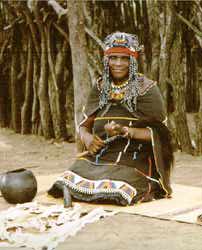 Via Mtabatuba
we visit St. Lucia Wetland park. It is the first site that South
Africa has officially applied for World Heritage Status. The
protected area is the largest estuarine lake system in Africa. St Lucia
therefore become one of South Africa's most popular tourist resorts. Here we
made a boat trip over the wetlands which was a little bit dull, A big tourist
boat a couple of Hippo's and very far away some birds that all we saw.
Thus this trip was no more than a 1.5 hour sunbathe. Along the Indian Ocean
partly over the N2 we continued our trip to Durban
Via Mtabatuba
we visit St. Lucia Wetland park. It is the first site that South
Africa has officially applied for World Heritage Status. The
protected area is the largest estuarine lake system in Africa. St Lucia
therefore become one of South Africa's most popular tourist resorts. Here we
made a boat trip over the wetlands which was a little bit dull, A big tourist
boat a couple of Hippo's and very far away some birds that all we saw.
Thus this trip was no more than a 1.5 hour sunbathe. Along the Indian Ocean
partly over the N2 we continued our trip to Durban
The overwhelming impression of Durban is of a busy modern town suffering from to much traffic and too many people. Special the Seaside, there are so many attractions that it is difficult to entertain yourself because they want entertain you. During our morning and evening walk along the beach, you will feel yourself unhappy because everybody is jogging in sweat and you're quit walking. One of the attractions Sea World is worth seeing, they have a large collection sharks in a big aquarium and a nice dolphinarium. The really good performing seals and dolphins are very popular. Also the Botanic gardens a classic example of a Victorian garden is a very pleasant place to visit.
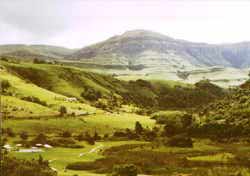 From
Durban we travelling via Pietermaritzburg and Howick along the Midmar
Reserve direction Nottingham Road and Rosetta through the valley of
the 1000 hills to Mooi River direction Giant's Castle Reserve. A
beautiful trip through breathtaking landscape. On the way we made a stop at
the view point World view were the ruts whom by many ox wagons made
during the Great Trek can be clearly seen. The area around Kamberg was
inhabited by Bushmen who left some of their most vivid paintings in shelters
along the upper reaches of the Mooi River. But the San paintings we saw are
disappointed, a cave full of scaffolding and only a few paintings, the rest of
the caves are closed for public. But the walk to the cave and the beautiful
surroundings have saved the trip. Along the Ntabamhlope Resort, Draycot and
Loskop we go to the hotel Drakensberg, a perfect place with a magnificent
view of the Drakensbergen with the highest mountain the Mafadi 3450 metres. A
beautiful garden with a private lake and a lot of rest. They organise daily
different hikes in the surrounding and we decide to join the 8 km hike to the
Blue cave which is according the reception not difficult. The hike was going
through the densely bush with moss-grown trees and high ferns, bromeliad's,
wild orchids, monkeys, and snakes through very small passages and rivers,
clefts, sheer slopes with much clamber and slither, but it was breathtaking
beautiful. The final destination was a nice cave with a waterfall inside. Wet
and extremely dirty we went back following a easier way but we enjoyed the
trip very much. After some rest and a lunch at the swimmingpool we have done
the hike to the Fern Forrest
From
Durban we travelling via Pietermaritzburg and Howick along the Midmar
Reserve direction Nottingham Road and Rosetta through the valley of
the 1000 hills to Mooi River direction Giant's Castle Reserve. A
beautiful trip through breathtaking landscape. On the way we made a stop at
the view point World view were the ruts whom by many ox wagons made
during the Great Trek can be clearly seen. The area around Kamberg was
inhabited by Bushmen who left some of their most vivid paintings in shelters
along the upper reaches of the Mooi River. But the San paintings we saw are
disappointed, a cave full of scaffolding and only a few paintings, the rest of
the caves are closed for public. But the walk to the cave and the beautiful
surroundings have saved the trip. Along the Ntabamhlope Resort, Draycot and
Loskop we go to the hotel Drakensberg, a perfect place with a magnificent
view of the Drakensbergen with the highest mountain the Mafadi 3450 metres. A
beautiful garden with a private lake and a lot of rest. They organise daily
different hikes in the surrounding and we decide to join the 8 km hike to the
Blue cave which is according the reception not difficult. The hike was going
through the densely bush with moss-grown trees and high ferns, bromeliad's,
wild orchids, monkeys, and snakes through very small passages and rivers,
clefts, sheer slopes with much clamber and slither, but it was breathtaking
beautiful. The final destination was a nice cave with a waterfall inside. Wet
and extremely dirty we went back following a easier way but we enjoyed the
trip very much. After some rest and a lunch at the swimmingpool we have done
the hike to the Fern Forrest
From Drakensbergen we travel to Pretoria via Winterton, Bergville, Sterkfontein Dam to Orange Free State via Harrismith partly via the service road to Soweto. Before entering Soweto we first pick up a black guide who will introduce to us to this black community. It is quite different as the press show us in the newspapers. It is a 100% black community but with real houses, big and small and also imposing residences, all the houses are equipped with water electricity and toilet. The houses are build very close together and in some areas the refuse collecting is better organised as others. But there is no slum and it is not pauperised. When you are introduced by a black, the people are very friendly, they invite you in their houses and in the Shabines you can get a very good lunch. Don't say anything wrong of Winnie Mandela, it will cause a big heavy debate with all the woman. The residence build by Winnie with the money collected for Mandela is located in the same area as the residence of Bishop Tutu. At the border of Soweto you will find some really slum, here are living a lot of refugees out of Mozambique.
 Pretoria, as with all South African cities the first building of any
substance to emerge was the church. In Aug 1854 work had started on a church
right by today's Church Square. In 1910, Pretoria was made the administrative
capital of the new state. Shortly after the Union Buildings were build to
house the government. The city has remained a centre for government and today
most overseas diplomats are based in Pretoria.
Pretoria, as with all South African cities the first building of any
substance to emerge was the church. In Aug 1854 work had started on a church
right by today's Church Square. In 1910, Pretoria was made the administrative
capital of the new state. Shortly after the Union Buildings were build to
house the government. The city has remained a centre for government and today
most overseas diplomats are based in Pretoria.
Union Buildings, this magnificent complex sits on the top of
Meintjeskop overlooking the centre of the city. The building was completed in
1913 the architect was Herbert Baker. The gardens below the building are
pleasant to walk about, but the best reason for coming here is the city view.
Voortrekkers Monument, the monument was completed in 1949 after 11
years of work. It was created to commemorate the Great Trek of the 1830s, when
the Afrikaners headed inland with just their ox wagons and a little idea of
what led ahead of them. Krugerhuis, the museum collection displays any
of the family possessions and objects relating to the Anglo-Boer War.
During the war the European governments sent him presents as they voiced their
support for the Boers, but Kruger needed arms and soldiers, not decorative
items.
National Zoological gardens is regarded as one of the best zoos in the
world, the animals are kept in extensive parklands, but despite all this it
just doesn't seem right so close to some magnificent wild country. Via Johannesburg
one usually flyes back home.